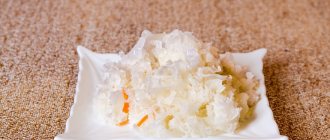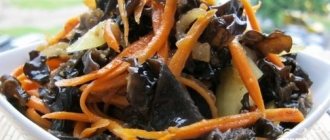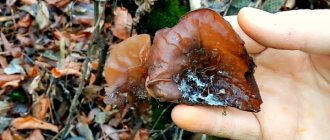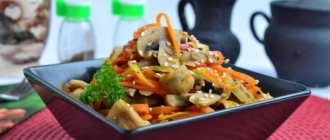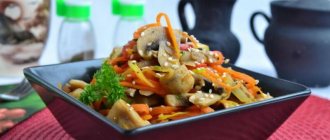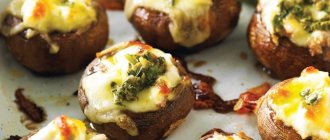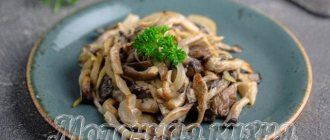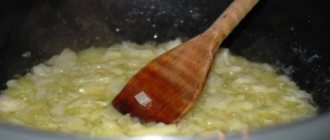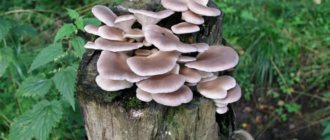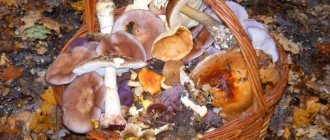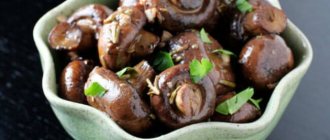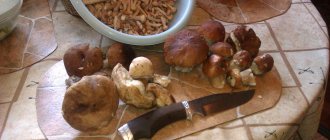In some exotic restaurants you can find such a dish - Korean-style corals. In fact, the main ingredient is not the inhabitants of the sea - it is just an unusual variety of mushroom . The most common name is coral mushroom, but it has many alternatives: ice, snow, royal, gelatinous.
In the East it is called the silver ear . Under natural conditions, it looks like ice among the greenery and is white in color. Previously, only the royal families and some members of the aristocracy of China and Japan could eat these mushrooms. Because of this fact, the product received one of its names.
Botanical characteristics
In appearance, the mushroom fruiting body is similar to algae or coral growth, which has numerous branches. It grows up to 7.5 centimeters in diameter. There is no clearly defined division into stem and cap.
In conditions of high humidity, the surface becomes slippery and jelly-like. The structure of the fruiting body is quite comparable to a transparent white gelatinous substance.
The mushroom has several names. The Chinese called it the silver ear, the Japanese called it the white tree ear. Scientific name: Tremella fucus.
Leads a predominantly parasitic lifestyle, settling on other representatives of the fungal kingdom. Forms and develops a fruiting body after invading foreign mycelium. However, it is still not clear whether this is parasitism or some other form of mutual coexistence of two organisms.
Poisonous false doubles
Inedible varieties of coral mushrooms include the following:
- Sticky Calocera (Calocera viscosa). Classified as belonging to the Dacrymycetaceae family. It grows from early July to October on wood buried in the soil, often in coniferous forests. Grows singly or in groups. The fruiting bodies are horn-shaped, 3–10 cm in height, the surface is sticky, the color is from golden yellow to orange-yellow, darkens to orange when dry. The pulp is dense, gelatinous, and odorless. Kalocera is considered inedible due to the rubbery consistency of the pulp.
- Xylaria hypoxylon. Belongs to the Xylariev family. Grows from September to October on stumps, rotting wood of deciduous trees, less often of conifers. Grows in groups or bunches. The branches are pointed at first, then become forked and fan-shaped at the top. The base of the fruiting body is brown-black. The pulp is dry, white, hard. Inedible look.
- Horn-shaped cornflower (Clavulinopsis corniculata). Belongs to the Rogatikov family. Grows singly or in groups in late autumn. Prefers mossy meadows and heather heaths, coastal hawthorn thickets, and damp wooded areas with a lot of ash. The fruiting body of the horntail has a branching shape and is sulfur-yellowish to reddish in color. The base is white and has a felt surface. The pulp is brittle, with a powdery odor. Inedible.
To appreciate the diversity of coral mushrooms, pay attention to the photo.
Chemical composition and calorie content
The calorie content of ice mushroom is low: about 86 kcal per 100 g (for cultivated mushrooms).
Chemical composition:
- 1.6 g protein;
- 4.3 g fat;
- 2.8 g carbohydrates;
- 91.3 g water.
There is no dietary fiber.
The vitamin and mineral composition is represented by a huge number of amino acids, organic acids and sugars, but two main elements can still be clearly distinguished:
- calcium – 643 mg;
- iron – 30.4 mg.
The calorie content of Tremella fuciformes grown in the wild is on average 56 kcal per 100 g.
The calorie content of pickled ice mushroom is already 376 kcal per 100 g.
How to cook
Requirements for dishes
To prepare white woody Chinese mushroom, you need a bowl or bowl with a wide bottom (ceramic, glass or enameled iron) so that the entire mushroom fits in it.
I had a 750 ml ceramic bowl - wide and flat. The mushroom fit comfortably into it and did not reach the edge (top of the bowl) a couple of centimeters.
How to do
- Place salt, sugar and vinegar on the bottom of the dish. Add spices (if you use them. But in my opinion, there is no need at all, and without them there will be a characteristic taste, like the Koreans).
- Place the mushroom in a bowl. Pour boiling water over it (the dry mushroom should disappear under water. Don’t pour too much water; once it disappears, that’s enough).
- After 1-2 minutes, the mushroom will straighten and marinate. Drain the marinade. All! White wood mushroom is ready to eat! You can eat!
Beneficial features
The benefit lies in two main chemical elements that are included in the composition.
- Calcium: acts as the main building material for the bones of the body. And also: regulates the functioning of the nervous system and takes part in the process of muscle tissue contraction. Calcium deficiency leads to demineralization of the components of the spinal column, pelvic bones and lower extremities. Lack of calcium in the body is one of the causes of osteoporosis.
- Iron: present in various protein compounds, incl. in enzymes. In addition: it takes part in the process of transporting oxygen and electrons, and also acts as a means of ensuring redox reactions, and activates lipid peroxidation. Iron deficiency conditions cause hypochromic anemia, skeletal muscle atony, which is one of the causes of chronic fatigue, myocardiopathy and provokes atrophic gastritis.
In addition to calcium and iron, the chemical composition contains small amounts of phosphorus, magnesium, sodium and sulfur, amino acids, glycogens and vitamin D.
The benefits of ice mushroom for human health are multifaceted:
- increases the body's protective properties against the effects of radiation;
- strengthens the respiratory system;
- improves the activity of the circulatory system;
- reduces cholesterol levels in the blood;
- has an anti-inflammatory effect;
- has anti-allergenic functions;
- removes toxins;
- strengthens the nervous system;
- increases performance;
- accelerates metabolic processes;
- participates in cell regeneration and slows down the aging process.
Possible harm
There are a number of restrictions for use, non-compliance with which can be harmful to health. Such factors include children under 3 years of age, pregnancy and lactation.
It is also not recommended to use it simultaneously with taking medications that reduce blood clotting. Having the exact opposite effect, it has a neutralizing effect on anticoagulants.
It must be remembered that there is an individual hypersensitivity of the body to certain substances. For some people, Tremella fuciformes may be such a problem product.
Medicinal use
The beneficial properties of tremella are widely used for medicinal purposes.
Immunity
The mushroom is able to remove toxins from the body
The mushroom mucous structure contains polysaccharides that are involved in the process of production of protein compounds by the human body - interferon and interleukin-2 from the group of cytokines. These substances are indispensable for sustainable immunity and stimulate the formation of macrophages absorbing microbes. In addition, the fungus is characterized by the ability to activate the activity of “natural killer” cells and increase the effectiveness of antibodies.
Thus, the main task of interferons is to induce and activate cellular proteins that block the development of the virus. Interleukins are part of the immune system and are mobilized in response to pathological influences on the body.
Oncology
Due to the beneficial properties of the mushroom to promote blood clotting and activate the process of platelet production, alternative medicine has found use for it in the prevention and treatment of cancer.
Some laboratory studies show it has a positive effect on blocking the growth of cancerous tumors, which can help improve the effectiveness of medications and treatments.
The platelet activating factor (PAF) present in the chemical composition of the ice mushroom is responsible for the formation of the so-called. fibrin network of blood vessels to nourish tumor cells and prevent blood clotting. They were also found to have the ability to prevent leukopenia in cancer patients - a drop in the number of white blood cells as a result of chemotherapy or radiotherapy.
The use of tremella at the final stage of cancer treatment accelerates the process of restoration of bone marrow cells after exposure to radiation during chemotherapy.
Benefit
The Chinese ice mushroom stands out among others due to its unique appearance, but that is not why it is valued. The mycelium has an unusual sweetish taste, more like the meat of some sea creatures than a forest plant. But this is not the main reason for the greatest veneration and worship of the inhabitants of the Celestial Empire. Tremella is truly unique in a medicinal sense.
An interesting feature of the coral fungus is that it is a parasite; it sucks out all the useful vitamins and minerals accumulated over decades from the trunks of fallen trees. One scallop contains a whole storehouse of useful substances, which makes it incredibly valuable for humans.
The exotic product improves immunity, accelerates cell regeneration, improves blood circulation, thereby reducing the risk of the occurrence and development of varicose veins and thrombophlebitis, reduces glucose levels, breaks down bad cholesterol, and strengthens blood vessels. Consumption of mycelium is beneficial for cardiovascular activity, respiratory and digestive systems.
Tremella instantly gives the body strength, which helps it fight numerous diseases, including chronic ones. The healing property is explained by the multi-vector strengthening effect on the immune system. Coral mushroom makes the immune system strong, which allows you to successfully fight a variety of diseases, from common colds to oncology. Read more about the benefits of white wood mushroom.
Places of growth and fruiting time
The main place of growth is the habitat of the host fungus, i.e. fallen branches or logs of dead hardwood trees, mainly from the evergreen Indian mango. The range covers the tropics and subtropics of the Asian and Central American continents, as well as Australia, New Zealand and the Pacific Islands. It grows and bears fruit all year round.
In Russia, it can only be seen in Primorye or Sochi, where it appears in oak forest belts only in hot weather, starting in June and ending in September.
Use for culinary purposes
Since the 19th century, residents of Asian countries began to use tremella for culinary purposes. The mushroom has gained popularity among chefs due to its delicate structure. It does not have its own taste, but the structure is capable of absorbing it from other components with which it interacts.
Tremella also acquires a smell in the same way. So, growing in mango thickets, it will have a pine smell and honey taste. Collected from an oak grove, it will have a woody aroma.
Among Asians, ice mushrooms have become one of the main ingredients in the preparation of sweet desserts; soups and drinks are prepared from it.
The so-called is considered original in Asian countries. An “Asian dessert” that includes fresh mushrooms and canned peaches. And although its preparation (more precisely, infusion) takes 24 hours, this does not stop gourmets who consider this dish an exquisite delicacy.
To preserve beneficial properties, long-term heat treatment is contraindicated.
The duration of preliminary steaming of dry mushroom is up to 5 minutes, Korean marinating and salting is up to 10 minutes, cooking time for hot Korean snacks is up to 0.5 hours.
At home, you can prepare a variety of salads with tremella fruit bodies, combining radishes, cucumbers (fresh, salted), and eggs. If the dish is included in the menu for health purposes, then there is no need to boil the mushrooms. Since the tremella sold in supermarkets is artificially grown, it is almost impossible to get poisoned by it. It is only important to remember that there is individual intolerance to this fungus.
Sparassis curly - description of where it grows, the toxicity of the mushroom
Sparassis curly is understood in the literal sense of the word as a curly beige mushroom, which is classified as a member of the Sparass family. There are no more than 7 varieties in this family, which is remarkable. The mushroom is an edible and very tasty variety, but it is listed in the Red Book of our country as an endangered type. Due to deforestation and human gathering, the number of specimens presented is decreasing. Today we will study everything connected with them.
Description
Let us repeat once again that this variety is classified as edible. The mushroom attracts attention, first of all, because it is famous for its external characteristics. In common parlance it is called by many different names, including mushroom cabbage, lamb mushroom, mushroom happiness, as well as hare cabbage and king mushroom. Moreover, the name “lamb” is used only in foreign reference materials; our compatriots practically do not express it this way. Russian experts by lamb mean a completely different mushroom - curly griffola. Now consider the description of the presented intricate specimen. The fruiting body consists of multiple curly leaves that branch and look like a shrub.
The mushroom is quite large; its wrinkled lobes with wavy edges cannot go unnoticed. Considering the diameter, we can say that some fruiting bodies grow up to 20-60 cm. Of course, this is rare; on average, mushrooms with a diameter of 7-30 cm are found. The height of the bush is about 20 cm, and its weight exceeds 6-8 kg . Some mushroom pickers came across specimens weighing 10-14 kg. The fruit bodies are beige, yellow-white in color. Mature specimens have a dark, brownish color with reddish splashes. The base is poorly visible, it is root-like, attached to the center of the body.
The thickness of the leg is about 5 cm, for the most part it is dug into the ground, so it is not visible. It grows up to 13 cm in length, is colored white-yellow, and can darken and turn black when overripe. The soft part of the peculiar wavy blades is fragile, easily crumbles and breaks. In mature fruiting bodies it is tough and hard. It tastes nutty and smells strange. The smell has nothing to do with mushroom aroma. Reproduction is carried out by elliptical-shaped spores; they are light yellow or white in color. The layer, otherwise called spore-bearing, prefers to be located on each blade. Moreover, it occupies only one side, without completely wrapping around. In hue, this layer is pigmented creamy white or gray. Feels a little rough, maybe too smooth.
Use in cosmetology
Cosmetologists include practical use among its beneficial properties and use it as a product that moisturizes the skin and can make it soft and elastic.
Natural polysaccharides easily penetrate into the deep layers of the epidermis and have a rejuvenating effect from the inside, retaining moisture in the cells.
The acidic polysaccharide extracted from the fruiting bodies of tremella is similar in its physical and chemical characteristics to hyaluronic acid. Its excellent moisturizing effect, as well as its high ability to retain water, were extremely highly appreciated by manufacturers of detox products for regular use in urban conditions and dry air environments.
Tremella fucus has the only strict contraindication – individual hypersensitivity to this product. Tremella is included in anti-age and anti-stress products for the skin, and now also in protective products for hair. The optimal working concentration of the component in the finished product is considered to be in the range of 0.02-0.5%.
Tremella extract used in cosmetology is stored exclusively in powder form.
Comments
Oh! This is exotic. What does it taste like?
spicy Korean salad.
Mushroom as a product is uninteresting (even fresh). You could decorate it with your own interesting, unusual dressing. the assessment would have been different. 2. P.S. he really loves (I was even surprised that it wasn’t in the dish) soy sauce
Well, wow! You can even cook corals! Surprised by 5 points!
For the recipe 5. I invite everyone to visit. I have a recipe for salad with corals.
As I understand it, some kind of mushroom is called coral? And here they are pickled. What's wrong with that? Or wrong? 5
Amazing! This is the first time I have seen such a product. Thanks for showing me. I would be grateful if you tell me where you bought it and the correct name 55555+
what do they eat?
These are mushrooms. They are called corals, you may have heard other names: sea mushrooms, burdocks, etc. They are sold in markets where they sell Korean salads. That is, you can ask the sellers for their dry version and they will sell it to you from under the counter, or order it online or purchase it in specialized stores. They are prepared without soy sauce and are very tasty.
Night, you’re in vain, mushrooms are a very tasty product, I adore them in any form.
And we sell a lot of dry things, but there are no koralchiks ((( Although they sell ready-made ones, it’s amazing. If I’m not mistaken, this dressing already contains soy sauce!
Yes, there is soy sauce and oil and red pepper and a lot more, all the sauce is already ready.
We really love these mushrooms. I’ve never seen dry ones. Boom look!
Olga Ivenskaya “Healthy avocado. 40 avocado recipes from appetizers to desserts."
Despite the name, the coral mushroom has nothing in common with the sea; it chooses a cozy place on the stumps and trunks of fallen trees. The coral mushroom is simply a miracle, it has a beautiful exotic appearance, reminiscent of a branch of sea coral, it is a real pearl of nature - translucent snow-white lace. In addition, mushrooms are very healthy and nutritious: they contain about 70% dietary fiber, proteins, carbohydrates, minerals, as many as 18 valuable amino acids, they are a real storehouse of plant glycogens (special polysaccharides), necessary for immunodeficiency, serious stress, to slow down the aging process and memory improvements. Coral mushroom has many names: sea mushroom, snow, gelatinous, ice mushroom, royal, tremors, silver ear. The scientific name is tremella fuciformis. The coral mushroom, which has come into fashion recently, quickly acquired its own army of loyal fans.
The flesh of the mushroom is fleshy, at the same time tender and crispy, elastic-gelatinous, springy, usually odorless (rarely has a pleasant faint odor).
Before use, coral mushroom needs additional preparation. Pour the required amount of coral mushrooms with water at room temperature for a period of 30 minutes to several hours (depending on the dish in which they will be used), the mushroom will absorb the water and fully open. It should be taken into account that when the mushroom swells, it increases in size by 8-10 times. Then rinse the mushroom and divide it into small inflorescences with your hands, maintaining a beautiful wavy shape. If there is, cut off the hard parts at the base.
The simplest recipe is to marinate coral mushrooms. Wonderfully delicious, you just can’t stop eating! They are unique, unlike anything else, slightly crispy, very thin, with a sharp and sour taste. The spiciness inexplicably arises even without the addition of pepper - from a simple marinade of vinegar, sugar and salt. The pickled translucent white mushroom can be eaten on its own as a savory snack. But you can serve it with potatoes (boiled, stewed, fried, mashed), with sweetish beef stewed in tomato sauce and with other dishes that require a light hot and sour appetizer, for example, instead of pickled peppers.
Marinated mushrooms go well with fish - to prepare a healthy, low-calorie dish you need to combine steamed fish, vegetables and marinated mushrooms - serve them on white or brown rice.
You can add pickled mushrooms to Korean carrot salad, and to salads where pickled cucumbers and capers are usually added. Because the delicate and at the same time elastic, crunchy structure of the coral mushroom is magnificent and unique.
Coral mushrooms are great for scrambled eggs, a great combination of eggs and lightly fried mushrooms, the lack of slimy texture creates the perfect dish. Add your favorite ingredients such as onions, peppers, ham and cheese.
The following dish with coral mushroom is definitely for gourmets:
Place the coral mushrooms, soaked for 30-40 minutes and washed, in a pan with chicken broth and simmer briefly over low heat. After the mushrooms have absorbed most of the broth, lightly fry them with vegetable oil, garlic and white wine. Then evaporate excess moisture over medium heat with the lid open for 5-7 minutes. Usually these mushrooms are served as a separate appetizer, as well as with various vegetable side dishes, boiled potatoes with butter and herbs, mashed potatoes, and crispy fried potatoes. It's a matter of taste here.
A very popular recipe is coral mushrooms with meat.
Ingredients:
- 100 grams of coral mushrooms
- 3 green onions
- 1 onion bulb
- 3 small cloves of garlic
- 1/2 teaspoon salt
- 1/2 teaspoon ground white pepper
- 1 tablespoon vegetable oil for frying
- 1 - 2 teaspoons dark sesame oil
- 200 grams of your favorite meat - beef, pork or chicken
Preparation:
1. Divide the coral mushroom into separate inflorescences; if the inflorescences are large, cut into strips and rinse well in cold water. Place in boiling water, bring to a boil and cook for two to three minutes. Remove from heat, drain in a colander and rinse with cold water.
2. Cut the meat into strips approximately the same size as the mushroom strips, lightly salt and sprinkle with a little pepper, let stand for ten minutes.
3. Place the mushrooms in a bowl, sprinkle a little salt and pepper, stir and let stand for ten minutes.
4. Chop the green onions.
5. Cut the onions into thin rings.
6. Crush or mince or finely chop 3 cloves of fresh garlic.
7. Place mushrooms, onions, garlic in a bowl, mix well.
8. Heat olive oil (or other vegetable oil for frying) in a frying pan over medium heat for thirty seconds.
9. Add meat strips to the heated oil and fry until browned.
10. Add the mushroom mixture and fry for four to five minutes, remove from heat, drizzle with sesame oil and garnish with green onions.
Serve as a main meat course with any side dish or with Korean food as part of banchan (a general name for various appetizers and salads in Korea that are served as an accompaniment to the main dish and rice, in small shallow bowls).
Good day. I've been using recipes from the site for quite some time. And today for the first time I didn’t find the recipe I was looking for. This is my debut - I hope for leniency.
Korean-style corals can be found in Korean rows in Russia. But this is too far. Today I wandered into a Thai store and to my delight I found dried mushrooms. But I couldn’t find how to cook them on the Internet. So I improvised and it turned out just what I needed!
So we will need: - dried corals - 25 gr. - seasoning for Korean carrots - salt - sugar - red pepper - garlic
25 gr. That's about the same amount of coral
pour a liter of boiling water over them, add sugar and salt, leave for 30 minutes
After this, they need to be thoroughly rinsed under cold water to get rid of sand, if there is any there. Cut off the hard parts at the base (their presence depends on the quality of the mushrooms)
Now add seasonings: a teaspoon of salt, sugar, and seasoning for carrots, red pepper (to taste, depending on your preference) and garlic, also not for everyone. I don’t eat too spicy, I added 3 cloves. You can also add sodium glucomate to enhance the taste. I like it with it, but if you don’t like it, you don’t have to add it, and it’s still delicious.
Mix everything well and marinate in the refrigerator for 2 hours.
I hope you will enjoy. Mine were delighted. But corals will be even tastier if you eat them the next day. But who can endure it?
This is Tremella fucus, aka “Snow fungus”, aka “Ice mushroom”, aka “Snow mushroom”, aka “edible gelatinous mushroom”, aka “coral mushroom”
Here is an article about it with a couple of recipes. Maybe someone on the forum will find it useful https://heidrek.twilightes.com/index.php?page=9
| Bagheera-Mango wrote: |
| pilgusha Natalya, are corals mushrooms? Did I understand correctly? If this is what I think, then we sell them already in a marinade, just like Korean salads. My son and I love them very much. We often buy them, but they are already prepared, marinated. I haven't met anyone else. |
That’s right, these are pickled mushrooms, but they also sell carrots, but many people make them at home. But we don’t sell Korean salads, so we’re having fun.
| Irincha wrote: |
| I think the portion will be small. I’ll eat 25 grams and won’t notice. |
25 grams is in dry form, and when they soak, you get a full portion plate, you can compare what I showed in dry form and the finished product.
Ingredients:
Dry corals - 4 pcs.
Garlic -5 cloves
seasoning for korean dishes
How to cook:
Place the corals in an enamel bowl and pour boiling water over them so that it covers all the mushrooms.
Add salt, sugar. And leave for 30 minutes. The mushrooms increase in size very much, so don’t be greedy (about 5 times).
Rinse under cold water. Rinse thoroughly, a lot of sand and some kind of dirt
Chop mushrooms and add dressing
Add crushed garlic through a garlic press, salt, sugar to taste. Leave to marinate for 1.5 hours. Bon appetit!
This seasoning gives it a taste just like store-bought salads at the market. It is sold in regular supermarkets and is not expensive.
Coral mushroom has many popular names: gelatinous, silver ear, icy, royal, trembling, snowy. All these are alternative names, and the real (scientific) name sounds like “fuchsian tremella” (tremella fuciformis).
The coral mushroom was first described by the Englishman Joseph Berkeley back in 1856. However, the Asian world learned about it much earlier. Local herbalists sold white coral mushroom as a miracle cure for colds. It was also an excellent tonic. Transliteration of Chinese characters leads to another interesting name: “snow tree ear”, and in the Japanese version - “tree white jellyfish”.
Coral mushroom is quite nutritious. It contains about 70% dietary fiber, 18 amino acids, vitamins, carbohydrates, proteins, minerals, and plant glycogens.
For many centuries, coral mushroom was used by the Chinese in the treatment of tuberculosis, colds, and hypertension.
Recent studies by scientists from Ukraine and Israel have confirmed: tremella fuchsoidum can increase immunity, protect against radiation, strengthen the respiratory system, improve hematopoiesis, and reduce cholesterol levels. Moreover, coral mushroom has anti-allergic and anti-inflammatory properties. It prevents the development of tumors and neurological damage, protects the liver from toxins, has a positive effect on the brain, and improves memory.
Due to the content of natural vitamin D, coral (white) mushrooms rejuvenate the skin, accelerate metabolism, and increase blood flow in the skin cells. Important: Tremella fuchsoides is strictly contraindicated for those patients who are taking (or have just finished taking) anticoagulants. The coral mushroom has practically no independent taste. Tremella's popularity is due to its crunchy, firm, yet tender texture. Many soups, salads and even desserts are prepared from it. In powder form, coral mushroom is added to drinks and ice cream.
The Chinese way of preparing one of the sweet dishes based on this mushroom is very interesting: tremella is boiled, then dried and soaked in sweet peach syrup.
Dried “silver ear” needs additional processing. First, the product is poured with warm water for a couple of hours until it swells (increases tenfold), then it is washed and, after the excess water has drained, it is divided into small inflorescences (hard areas are removed). After this, you can start cooking. Once upon a time, the coral mushroom was so rare that only the very rich could afford it. Now tremella is grown on an industrial scale and is quite affordable for the average buyer. You can see it in most Asian grocery stores.
Coral mushroom is stored in the refrigerator in tightly closed, airtight containers.
The ice mushroom is a representative of the Drozhalkov family, the genus Drozhalka. Its description was made in 1956 by the scientist M. Berkeley, but Tremella fuciformes (botanical name) was highly valued by gourmets and culinary specialists in Asia long before it was included in the register of world flora. The mushroom has many names: snow, silver, sea, tree jellyfish, fucus tremors, silver ear. This is not surprising, since the fruiting body is so different from the standard type. On one squat leg, with the help of which the mushroom is attached to the tree, there are many winding blades-twigs, each of them has a lot of folds. The diameter is small - up to 10 cm, the color is snow-white, in rare cases yellowish, the flesh is elastic, very tender, gelatinous, reminiscent of jelly in consistency. The aroma is weak, spicy. The mushroom can be found in tropical forests on large-deciduous trees, more often in oak groves, in Primorye Russia, New Zealand, Asia, Japan and China. Can grow in colonies or singly. Considered a delicacy in Asian cuisine, it is grown artificially. In China, coral mushroom began to be cultivated 100 years ago.
Growing at home
The difficulty of growing tremella fuciformes at home is due to the mushroom's requirement for heat. The propagation of mushroom mycelium requires a specific – hot climate, which is quite difficult to create in Russian conditions, even in greenhouses. The investment may not be worth it.
For germination, mushroom pickers use fallen trees, drilling holes in them into which the mycelium is placed.
The approximate cost of mycelium for home cultivation is about 250 rubles per package.
Clavulina rugosa
This edible coral does not bush as much as previous representatives, but this makes it look no less exotic. Chefs classify the mushroom into the fourth category, that is, it is not considered very tasty, but with proper preparation and the addition of the right spices, the taste of clavulina can be filled with bright accents.
What does it look like
The name makes it clear what this forest inhabitant looks like: the fruiting body has large furrows resembling wrinkles. To many people, clavulina looks like animal horns. At a young age, there are peaks at the tops, but over time they become blunter, as the body constantly grows in width and reaches a diameter of 40 cm with a height of 15 cm. The branches have a pale cream color.
Where does it grow
Clavulina does not like company, so it always grows alone. Her favorite place is coniferous forests, but occasionally she prefers to live on mosses. The fruiting period is from late August to October, and in dry years fruiting bodies may not form.
Some facts about ice mushroom
Tremella was originally discovered and described in 1856 by British botanist Michaels Berkeley. Since that time, Chinese residents have been actively growing it for culinary purposes. The annual harvest of these mushrooms there amounts to 130,000 tons.
Today in Asian alternative medicine it is widely used as a remedy for colds and coughs.
When soaked, the body of the mushroom increases 5-6 times. The price starts from 300-500 rubles. for a fresh product and reaches 1300 rubles per 1 kg of dried fruiting bodies.
Step-by-step recipe for preparing a Korean dish
Shellfish meat for salad is used both raw and after scalding with boiling water. You should not cook the clam for a long time, otherwise it will become tough. To cook scallops the Korean way, you need to stock up on these products
- King scallops 1 kg
- Onion 200 gr
- Bell pepper 200 gr
- Carrots 100 gr
- Cucumber 200 gr
- Garlic 5 cloves
- Table vinegar 9% 3 tbsp/l
- Sugar 1 tsp
- Sunflower oil 4 tbsp
- Sesame oil 1 tsp
- Roasted sesame seeds 1-2 tsp
- Salt, pepper (red and black) - to taste
Those who are confused about using scallops raw (although in fact they are marinated), first scald them with boiling water, and then make the salad as indicated above.
